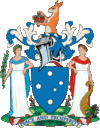- Director of Public Transport
-
Director of Public Transport
(DPT)Type Government Agency Predecessor Public Transport Corporation Founded 1999 Founder(s) Government of Victoria Headquarters Melbourne, Victoria, Australia Area served Victoria Key people Hector McKenzie (Director of Public Transport) Services Promote, provide, coordinate and regulate public transport in Victoria 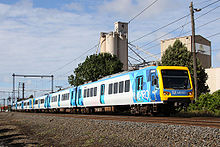 Metro Trains Melbourne set 755M in Metro livery, part of the suburban train fleet in Melbourne. The Director of Public Transport has entered into a franchise contract with Metro for the provision of train services in metropolitan Melbourne.
Metro Trains Melbourne set 755M in Metro livery, part of the suburban train fleet in Melbourne. The Director of Public Transport has entered into a franchise contract with Metro for the provision of train services in metropolitan Melbourne.
The Director of Public Transport (the Director or the DPT) is the Government agency responsible for promoting, providing, coordinating and regulating public transport in the State of Victoria, Australia. The DPT was created as a statutory office and is supported by officers of the Department of Transport.
The key responsibilities of the Director centre on the entering into and management of franchising contracts with train, tram and bus companies to provide public transport services in Melbourne and Victoria. The Director also has oversight of the Victorian Taxi Directorate which regulates the taxi and hire car industry in Victoria. As part of his operational functions, the DPT also has responsibilities relating to public transport planning and projects as well as the accreditation of passenger transport companies for enforcement purposes and the appointment and management of authorised officers for enforcement activities across Victoria's public transport system.
Contents
Main responsibilities
Trains, trams and buses
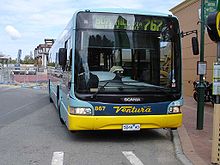 Buses operated by private providers under contract to the Director of Public Transport pay a key role in Victoria's public transport system.
Buses operated by private providers under contract to the Director of Public Transport pay a key role in Victoria's public transport system.
The most prominent responsibilities of the Director of Public Transport concern the contracting of transport operators to provide train, tram and bus services in Melbourne and Victoria. Accordingly, the Director is responsible for procuring these services through operators and entering into and managing franchise contracts. The current key franchise contracts entered into by the Director relate to -
- Trains in Melbourne (contract with Metro Trains Melbourne)- these services cover the provision of suburban rail services in Melbourne
- Trams in Melbourne (with KDR Melbourne) - these services cover the provision of suburban tram and light rail services in Melbourne
- Trains in regional Victoria (with V/Line Corporation) - these services cover the provision of train services in country and regional Victoria
- Bus services in Melbourne and wider Victoria including school bus services (with a wide variety of bus operators)
Train and tram services in Victoria are governed by complex statutory, Government and commercial relationships. VicTrack is the custodian of all rail infrastructure and assets in Victoria. VicTrack leases these infrastructure and assets to the Director of Public Tranpsort through the Metropolitan Infrastructure Head Lease. The Director then sub-leases the assets to the metropolitan train and tram operators through the Infrastructure Leases. The Director manages the rights and obligations contained in these leases on behalf of the State. The Director has also entered into franchise agreements with the metropolitan train and tram operators that govern the provision of public transport passenger services. The franchise agreements specify a range of operational and service requirements that are administered and managed by the Director.
In relation to regional train services operated by V/Line Corporation, similar arrangements have been entered into with VicTrack and the Director. VicTrack leases the regional train infrastructure and assets to the Director, who then sub leases these assets to V/Line Corporation under the Regional Infrastructure Lease. Similarly, the Director and V/Line Corporation have entered into a franchise agreement which governs the operational and service requirements for regional train services.
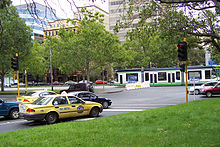 Taxis and trams in Melbourne. Taxis in Victoria are regulated by the Victorian Taxi Directorate, a business unit in the office of the Director of Public Transport.
Taxis and trams in Melbourne. Taxis in Victoria are regulated by the Victorian Taxi Directorate, a business unit in the office of the Director of Public Transport.
Taxis and hire cars
See also: Taxi Industry Inquiry and Taxi Services CommissionThe Director of Public Transport is currently the regulator of taxi and hire car services in Victoria.[1] A specialised Branch of the DPT is known as the Victorian Taxi Directorate (VTD) and conducts these services under delegation from the Director. The office of the Director, again through the VTD, is also responsible for the accreditation of commercial passenger vehicle drivers.[2] These responsibilities are conferred by delegation from the Secretary of the Department of Transport and will ultimately be assumed by the recently created Taxi Services Commission once it completes work on the current Taxi Industry Inquiry.
Other responsibilities
The Director is also charged with the accreditation of passenger transport companies for enforcement purposes and the appointment and management of authorised officers for enforcement across the public transport system.[3] The Director also has accountability for regulating the appointment and activities of driving instructors and administering a compensation scheme for traumatised train drivers.[4]
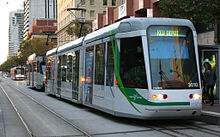 A tram operated by Yarra Trams under contract to the Director of Public Transport at Spencer Street in Melbourne.
A tram operated by Yarra Trams under contract to the Director of Public Transport at Spencer Street in Melbourne.
Governance
Establishment
See also: Transport Integration ActThe office of the Director of Public Transport was established in 1999 following the passage of the Rail Corporations (Further Amendment) Act 1998 through the Victorian Parliament.[5] The Director effectively took over responsibility for public transport in Victoria from the former Public Transport Corporation on 24 August 1999.
The Rail Corporations (Further Amendment) Act inserted provisions[6] into the then Transport Act 1983[7] to create the office and its functions and powers. The office of the DPT has since been re-established under the Transport Integration Act 2010.[8]
Transport Integration Act
See also: Transport Integration ActThe Transport Integration Act provided the Director of Public Transport with new objects, functions and powers as of 1 July 2010.
Objects
The Transport Integration Act provides that the primary object of the Director of Public Transport is to "...provide, operate and maintain the public transport system...".[9] Other notable objects[10] of the Director include -
- ensuring, in collaboration with other transport bodies and public entities, that public transport operates as part of an integrated transport system which seeks to meet the needs of all transport system users
- managing public transport in a manner which supports sustainability by seeking to increase the share of public transport trips as a proportion of all transport trips in Victoria
- seeking to improve the environmental performance of public transport including by minimising its adverse environmental impacts
- contributing to social wellbeing by providing access to opportunities and supporting liveable communities
- promoting economic prosperity through efficient and reliable movement of public transport users while also supporting rail freight services
- improving the safety of public transport for public transport users.
Functions
The functions[11] of the Director of Public Transport include -
- constructing, maintaining or varying public transport infrastructure
- planning for the public transport system
- providing, operating or facilitating public transport including by entering or managing contracts for public transport services and purchasing and maintaining rolling stock
- developing policies and strategies to improve safety and security on the public transport system
- developing and implementing policies, plans and guidelines
- providing licensing and accreditation services
- monitoring and reporting on contractual performance.
Powers
The general and specific powers[12] of the Director of Public Transport include a broad range of powers in relation to land, contracting, rolling stock, tree clearance, breaking up roads, installing stopping places, closure of level crossings, stopping of traffic, etc.
Other Victorian transport agencies
See also: Transport Integration ActThere are a range of State agencies responsible for the transport system in Victoria. The Department of Transport (DOT) oversees and coordinates the activities of the agencies which can be divided into three main types - statutory offices, statutory authorities and independent transport safety agencies. Together with DOT, the agencies provide, manage and regulate transport system activities in Victoria including -
- heavy and light rail systems including trains and trams
- roads systems and vehicles including cars, trucks and bicycles
- ports and waterways including commercial ships[13] and recreational vessels
- some air transport systems.[14]
Statutory offices
The statutory offices include -
- the Director of Public Transport
- the Transport Infrastructure Development Agent.
These agencies are part of the Department of Transport but each has a distinct statutory charter and powers.[15]
Statutory authorities
The statutory authorities[16] are -
- the Roads Corporation (VicRoads)
- Victorian Rail Track (VicTrack)
- V/Line Corporation (V/Line)
- Taxi Services Commission
- the Linking Melbourne Authority
- the Port of Melbourne Corporation
- the Victorian Regional Channels Authority
- the Transport Ticketing Authority
- the Regional Rail Link Authority.
These agencies are structurally separate from the Department of Transport.[17]
Independent transport safety agencies
The independent transport safety agencies[18] are -
- the Director, Transport Safety (Transport Safety Victoria)
- the Chief Investigator, Transport Safety.
These agencies are part of the Department of Transport but are functionally independent and report to the relevant Ministers.[19]
Current developments
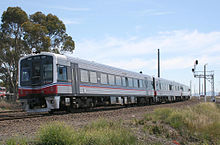 V/Line operated 'Sprinter' railcar at North Shore in Geelong in regional Victoria.
V/Line operated 'Sprinter' railcar at North Shore in Geelong in regional Victoria.
Major changes to the Director's responsibilities are underway due to decisions of the Victorian Government. The recent Transport Legislation Amendment (Taxi Services Reform and Other Matters) Act 2011 removed direct responsibility for taxi and small commercial passenger vehicle services and conferred it on the Secretary of the Department of Transport. This is essentially a transitional step before those activities are assumed by the Taxi Services Commission established by that Act. The Commission will take over regulatory control once it completes the current Taxi Industry Inquiry. More broadly, the Director's responsibility for the provision of train, tram and bus services across Victoria are likely to transfer soon to the proposed Public Transport Development Authority.
Public Transport Development Authority
Main article: Victorian Public Transport Development AuthorityA key policy of the Government leading into the election was to create a Public Transport Development Authority (PTDA). The Government has positioned the VTDA as an agency which will be independent and which will coordinate all aspects of public transport in Victoria.[20] [21] The Government has indicated that the authority will plan, co-ordinate, manage and administer metropolitan trams, buses and trains, regional trains and buses, replacing the current structure of multiple agencies. The body is expected to be fully established in mid 2011.[22] Planning for the Melbourne Airport, Rowville and Doncaster rail lines may be overseen by the new transport authority.[23][24] The authority may also contain a "High-Speed Rail Advocacy Unit".[25].
Taxi Services Commission
Main articles: Taxi Industry Inquiry and Taxi Services CommissionThe Government has announced a Taxi Industry Inquiry and the establishment of a Taxi Services Commission (TSC)[26]. The inquiry is headed by Professor Allan Fels and is underway. The TSC was announced as the successor to the current taxi industry regulator, the Victorian Taxi Directorate (part of the office of the Director of Public Transport), with the change of power to occur once the inquiry concludes. Legislation to this effect - a Transport Legislation Amendment (Taxi Services Reform and Other Amendments) Act 2011 - was passed in late June thereby the Taxi Services Commission. The statute provided the Commission with sufficient powers to conduct the current Taxi Industry Inquiry and to eventually become Victoria's taxi and small commercial passenger vehicles regulator.
See also
Main article: Cycling in MelbourneMelbourne has an extensive network of bicycle paths and bicycle lanes on roads. These paths are used for both recreation and for commuting.
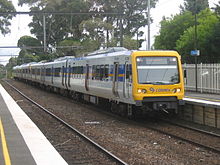 X'Trapolis 100 train operated by Connex Melbourne, the former Melbourne Metropolitan previous operator
X'Trapolis 100 train operated by Connex Melbourne, the former Melbourne Metropolitan previous operator
- Rail Transport in Victoria
- Railways in Melbourne
- Trams in Melbourne
- Buses in Melbourne
- Department of Transport
- Transport Integration Act
- Director, Transport Safety
- Chief Investigator, Transport Safety
- Victorian Public Transport Development Authority
- Taxi Industry Inquiry
- Taxi Services Commission
References
- ^ See Part 6, Transport (Compliance and Miscellaneous) Act 1983.
- ^ Drivers of taxis, hire cars and buses. This is also provided in Part 6 of the Transport (Compliance and Miscellaneous) Act 1983.
- ^ See Part 7, Transport (Compliance and Miscellaneous) Act 1983.
- ^ See section 12, Transport (Compliance and Miscellaneous) Act 1983.
- ^ Record of the progress of the Bill through the Victorian Parliament - http://www.legislation.vic.gov.au/domino/Web_Notes/LDMS/PubPDocs_Arch.nsf/5da7442d8f61e92bca256de50013d008/8FCA03558D5C3823CA2570D900161240/$FILE/532148%20status_report.pdf.
- ^ See former subdivision 2 of Part II of the former Transport Act 1983.
- ^ This Act was renamed from 1 July 2010 the Transport (Compliance and Miscellaneous) Act 1983 by the Transport Integration Act 2010.
- ^ See Division 1 of Part 5 of the Transport Integration Act 2010.
- ^ Section 66(1), Transport Integration Act.
- ^ Section 66(2), Transport Integration Act 2010.
- ^ See section 67, Transport Integration Act 2010.
- ^ Sections 68-72 of the Transport Integration Act 2010. A number of specific powers of the Director were retained in its former establishing statute, the Transport (Compliance and Miscellaneous Act 1983 (previously named the Transport Act 1983) - see sections 9C to 12.
- ^ Note, some shipping matters are controlled by the Commonwealth under legislation such as the Navigation Act 1912. Other matters are within the jurisdiction of States such as Victoria through Acts such as the Transport Integration Act and other statutes like the Marine Act 1988.
- ^ Note, many air transport regulation matters are controlled by the Commonwealth Government. The Transport Integration Act would apply, for example, to planning controls at some airports and in respect of transport connections to other airports by road and rail.
- ^ For information relating to the Director of Public Transport, see Division 1 of Part 5 of the Transport Integration Act 2010. The charter and powers of the Transport Infrastructure Development Agent are set out in Division 4 of Part 3 of the Transport Integration Act 2010.
- ^ See Parts 5 and 6, Transport Integration Act 2010.
- ^ The Act establishes these agencies as structurally separate bodies with their own legal personality. For example, section 81(4) of the Transport Integration Act 2010 establishes VicRoads as a "body corporate" which "may do and suffer all acts and things that a body corporate may by law do and suffer".
- ^ Part 7, Transport Integration Act 2010.
- ^ Section 194, Transport Integration Act 2010.
- ^ Coalition to Rebuild the Basics of Vic Public Transport Network
- ^ Baillieu revives airport rail link
- ^ Hoddle Street expressway plan ditched | Herald Sun
- ^ Baillieu revives airport rail link
- ^ http://www.news.com.au/national/mil-for-new-rail-links/story-fn8g495p-1226043922720
- ^ Baillieu pushes high-speed rail links
- ^ Premier of Victoria, media release, 28 March 2011.
External links
Victoria Topics History · Geology · State Government · State Parliament · State politics · Local government · Energy · Road transport · Rail transport · Sport · Education · Teaching
Regions Central Highlands · Gippsland · Grampians · The Mallee · Goulburn Valley · Melbourne · Port Phillip · Western Port · Mornington Peninsula · Yarra Valley · Bellarine · Sunraysia · Ovens and Murray · Australian Alps · Goldfields · Western District · Otways · WimmeraCities and towns Victoria portal Politics of Australia Commonwealth Queen · Governor-General · Prime Minister · Cabinet · Executive Council · Ministry · Foreign relations
Parliament · Senate · House of Representatives · Opposition Leader
High Court · Lower courts
Constitution Act · Statute of Westminster · Australia Act
Federal elections State/territory governments State/Territorial elections Most
recentNSW (2011 election) · Vic (2010 election) · Qld (2009 election) · WA (2008 election) · SA (2010 election) · Tas (2010 election) · ACT (2008 election) · NT (2008 election)
NextLocal government Political parties Government of Australia States and mainland
territoriesAustralian Capital Territory · New South Wales · Northern Territory · Queensland · South Australia · Tasmania · Victoria · Western Australia · Jervis Bay Territory
External territories Ashmore and Cartier Islands · Australian Antarctic Territory · Christmas Island · Cocos (Keeling) Islands · Coral Sea Islands · Heard Island and McDonald Islands · Norfolk IslandCategories:- Rail transport in Victoria (Australia)
- Public transport in Melbourne
- Railway companies of Australia
- Trams in Melbourne
- Light rail in Australia
- Tram transport in Australia
- Bus transport in Melbourne
- Government agencies of Victoria (Australia)
Wikimedia Foundation. 2010.



